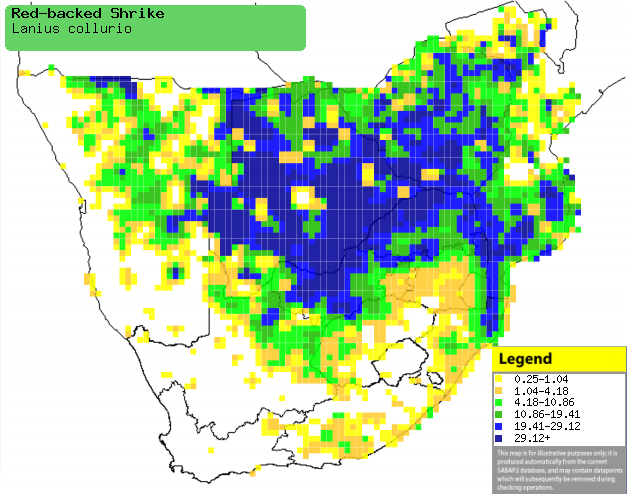|
Lanius collurio (Red-backed
shrike)
Rooiruglaksman [Afrikaans]; Ihlolo [Xhosa]; Nankuwo
(generic term for shrike) [Kwangali]; Temeli (also applied to Lesser grey
shrike and Common fiscal) [South Sotho]; Civo [Swazi]; Mghubhana lokhulu
[Tsonga]; Grauwe klauwier [Dutch]; Pie-grièche écorcheur [French]; Neuntöter
[German]; Picanço-de-dorso-ruivo [Portuguese]
Life
> Eukaryotes >
Opisthokonta
> Metazoa (animals) >
Bilateria >
Deuterostomia > Chordata >
Craniata > Vertebrata (vertebrates) > Gnathostomata (jawed
vertebrates) > Teleostomi (teleost fish) > Osteichthyes (bony fish) > Class:
Sarcopterygii (lobe-finned
fish) > Stegocephalia (terrestrial
vertebrates) > Tetrapoda
(four-legged vertebrates) > Reptiliomorpha > Amniota >
Reptilia (reptiles) >
Romeriida > Diapsida > Archosauromorpha > Archosauria >
Dinosauria
(dinosaurs) > Saurischia > Theropoda (bipedal predatory dinosaurs) >
Coelurosauria > Maniraptora > Aves
(birds) >
Order: Passeriformes > Family: Laniidae
Distribution and habitat
Its breeding territory is massive - including most of
Europe and western Asia. In the non-breeding season it moves south, with most
wintering in southern and east-central Africa but some staying further north in
Sudan, Egypt and Ethiopia. In southern Africa it is common in most areas,
excluding the west coast of Namibia and South Africa and large areas of the
Kalahari. Habitat preferences differ between the sexes: males favour open
habitats with fewer and smaller trees while females prefer denser, especially
Acacia woodland. It also occurs in grassland with scattered bushes and
trees, mopane and broad-leaved woodland. It has gradually been moving into
Kalahari scrub, the likely cause being that overgrazing has increased the
abundance of thorny bushes.
|
 |
|
Distribution of Red-backed shrike in southern Africa,
based on statistical smoothing of the records from first SA Bird Atlas
Project (©
Animal Demography unit, University of
Cape Town; smoothing by Birgit Erni and Francesca Little). Colours range
from dark blue (most common) through to yellow (least common).
See here for the latest distribution
from the SABAP2. |
Movements and migrations
It departs from its breeding grounds mainly during
August-September, with the males leaving first, later followed by the females
and sub-adults. Most of them arrive synchronously in southern Africa in and
around November, later departing during the first half of April.
Food
It mainly eats arthropods during the non-breeding season,
supplemented occasionally with small birds. It often hunts from a perch,
catching prey on the ground or on the wing. The following food items have been recorded in its diet:
- Arthropods
- Small birds, including:
- Berries (rarely)
Threats
Not threatened, in fact well represented in protected
areas, with a estimated global population of 10 million.
Links
References
-
Hockey PAR, Dean WRJ and Ryan PG 2005. Roberts
- Birds of southern Africa, VIIth ed. The Trustees of the John Voelcker
Bird Book Fund, Cape Town.
|
